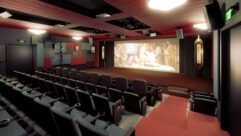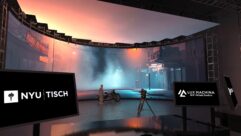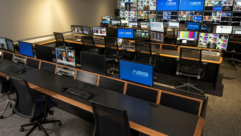
SVC Podcast – Show Notes – Show 130-2:
In this edition of the SVC Podcast, SVC Contributing Editor Bennett Liles talks with Mark Valenti of The Sextant Group about his upcoming Infocomm course, Future Trends in Higher Education. Mark outlines the need for future-proofing classrooms and establishing modern signal connectivity. He also discusses the solutions available for today’s educational AV environment and provides a preview of his course content.
Links of interest:
Download Podcast Here:
https://s3.amazonaws.com/nb-svc/public/public/130-2_Mark_Valenti_Sextant…
From Sound & Video Contractor Magazine, this is the SVC Podcast with Mark Valenti of The Sextant Group. Show notes for the podcast are available on the web site of Sound & Video Contractor Magazine at svconline.com.
AV technology is galloping ahead and the higher education classroom is ground zero for that seismic change. Mark Valenti with The Sextant Group will be teaching a course at Infocomm called “Future Trends for Higher Education,” and it’s full of tips and insight into what’s coming and how to future-proof today’s classrooms. That’s coming right up on the SVC Podcast.
Mark, it’s great to have you with us on the SVC Podcast from The Sextant Group and you’re going to be at Infocomm teaching a course on “Future Trends for Higher Education,” and that covers a lot of ground. In the course intro it’s mentioning a lot of changing technology in the classroom. That’s going to mean upgrades and there are shrinking budgets at the same time so how do people deal with that?
Well actually I think maybe there are some issues with operational budgets, but quite honestly we’ve seen, in our role as design consultants, we’ve actually seen audio/visual budgets grow over the last 10 or 15 years rather significantly. It’s not unusual for a new building on a campus today to exceed well over a million dollars, and two to three million is not unusual, so the essential nature of AV in the classroom in such that our clients actually are putting some pretty healthy budgets out there. I think where our clients tend to underestimate, or have in the past – that’s actually not true today – but in the past they’ve underestimated the ongoing operational cost of those technologies. But now we see a real market difference in the interest and total cost of ownership and ongoing operational expense. So we often are asked to now, because we’re developing our first pass at the budget for our project, is to actually begin to look at the TCO for the project and where the expendables are going to be and what the staffing cost might be. [Timestamp: 2:15]
I’ve experience that myself being an AV tech on a university campus. People have tended to buy and install dazzling new equipment while underestimating the cost of keeping all of that new gear up and running.
Yep. That’s very true. But there are some developments that give us hope. I truly think the transition from analog systems to digital systems is going to result in a much more robust and reliable AV environment. Once we get this HDBaseT thing through, really we’re still working through it as an industry in terms of what works/what doesn’t work, but I think they’re going to be much more reliable. We see in many classroom situations the upsized flat panel displays beginning to displace projectors. There’s no question that the flat panels are less maintenance intensive than projectors are.
That’s for sure.
Yep. When you’re in that 90-inch to 100-inch display range now, I mean you really have to sit down and decide whether this is a projection solution or a flat panel solution, and the flat panels offer so many benefits with light control and quality of image and so on; even the instructor being able to walk in the light path. [Timestamp: 3:24]
I notice in a lot of classrooms though, the projection surface is a pull-down screen over the whiteboard so they pull up the screen, mute the projector, then pull the screen back down and use the same space.
We laugh about that today, but that’s an artifact of imposing AV technology in a classroom that wasn’t designed for it.
Right.
And there are, let’s face it, thousands and thousands of classrooms across North America that were designed back in the 50’s and 60’s and 70’s and we never imaged back then that there would be digital projectors and flat panels, and so the attention wall was the writing surface for the instructor and so now there’s a clash, you know? But certainly in all the newer spaces that we’ve been designing for the last oh, 12 or 15 years, we’ve been able to design now to allow both writing surface and projection surface to coexist. [Timestamp: 4:13]
I noticed that in some of these places that, like you say, have been retrofitted, due to having been originally designed before AV and that’s the lighting. Sometimes you have to put in a very powerful projector just to overcome the ambient lighting which has to be either all on or all off.
Yeah, there’s no question about it. I mean the electrical engineer never imagined that the AV guy would be there, you know, and his design criteria are significantly different. He’s looking to minimize energy consumption. He’s looking to maximize lumens up to the desktop. He’s got safety concerns. There’s all kinds of things on his checklist that actually work against the AV guy or girl, and so AV systems are working – in many, many classrooms working overtime to try to compensate for lighting that was never intended for those kinds of systems. [Timestamp: 5:04]
Without getting too deep into hardware details, what can people do to in a general approach to sort of future proof their classrooms if they get enough money to do something serious?
Well first of all you have to look at the AV system and break it down by its components because the life cycle of components is different. What I call the end points, like projectors and cameras and so on, those are going to turn over pretty quickly. You’re maybe going to get three to five years out of those. Their switch gear, you know, routing switchers and so on, you’re maybe going to get five to seven years. But where you really get your money back is when you focus on the infrastructure and think about pathways for cabling and power that are going to let you reasonably turn over equipment over the next 20 years without having to do serious facilities modifications, because once you call the electrical engineer and the electrician, then it gets very expensive very quickly. If you’ve got to tear drywall apart to get to the plumbing, to get to conduit, your budget is going to be spent less on AV and more on facilities considerations. So I think the best place to focus your intention early is on the infrastructure of the project and if you can get that right then it makes turnover relatively straightforward. [Timestamp: 6:22]
Okay, so if you have the right connectivity solution, all you have to do is to plug in the updated boxes at each end.
Yeah, that’s true. And you know, as we go more increasingly digital and AV equipment becomes less reliant on dedicated cables – cable types – I think that that future proofing is gonna get a lot easier because we are going to become just another piece of equipment on the network. And so in many ways that infrastructure question becomes simpler. [Timestamp: 6:47]
Yeah. I’ve seen that everything used to be stand-alone extenders, say HDBaseT stuff, and now that’s being incorporated into the outputs of all kinds of things like presentation and matrix switchers.
That’s absolutely the case. I think we can reasonably expect in the next three to five years that a lot of dedicated AV switching is going to go away and it will just be handled by the network switch.
Mm-hmm.
Yep. And I know if I’m a manufacturer I’ve got to be scratching my chin, but if I’m an end user and I’ve got to go talk to my IT department, I’d better start that conversation now and not in two years or three years. [Timestamp: 7:21]
So what are you going to be doing in your course? What will you be offering as far as what they’re going to come away from this with?
Well there’s really three parts to it, Bennett. The first part is kind of setting up the educational context, what’s going on in pedagogy and how teaching and learning are being transformed by technology. The second part is a high level overview of various technology sectors from networking to display to conferencing; some of the edge stuff like holographic projection. And then the third part is how all of that is beginning to manifest itself in the learning space and how classrooms and teaching labs are really beginning to look like completely different environments from where they were 10 years ago. It was an awful lot of impetus and an awful lot of momentum right now in that learning space change and I think that’s really the biggest thing that higher ed AV folks will take away is what that means to them and their campus as they go back home and look around and say okay, where am I going to have to implement that and how am I going to do it? [Timestamp: 8:30]
You can walk in and see what kind of connectivity you need, where the equipment is going to go and what you want to do with it but one of the biggest challenges on this is the human side of it because people don’t like change.
Oh, that’s very true, but you know this is the one area where – I’ve had The Sextant Group for 20 years and I can tell you for the first 15 we felt like we were – when we’d walk away from a finished project with a job well done and a pat on the back, we felt like we moved the institution maybe a fraction of a degree, like kind of pushing the Queen Mary a little bit off course. But lately, in the last couple of years, we’ve seen some really deep interest, excited interest, high-level interest at administrative places, and really changing the way courses are taught and delivered and it’s really exciting. For me, I get really jazzed about that. There’s an awful lot going on that’s really positive and really exciting and it’s a great time to be in higher ed and in AV together. [Timestamp: 9:29]
Tell us a little about The Sextant Group. What have you been doing lately? Any kind of big projects that pertain to this?
Well The Sextant Group, we’re about to celebrate our 20th anniversary here in July. I’m very proud of that. We are 61 professionals in nine offices around the United States. We offer audio/visual design, IT design, security design, acoustics and technical lighting for stage and studio; anything with a camera we can light. And we like projects where we get to bring all of those disciplines to bear, where we actually get to collaborate internally and really develop solutions that are thought through from both the acoustical side and the visual side. Obviously we’re AV folks at our core. We’ve had a number of great projects recently. Libraries are a very hot topic. Libraries are – actually I would say there’s a revolution right now in the U.S. and Canada in libraries. They’re rethinking their central mission and becoming less of a warehouse for books and more of an information portal with all kinds of absolutely spectacular AV solutions that are manifesting. A lot of visualization; big data is causing our clients to think about how they interact with that data and so visualization walls of all shapes and sizes have been a very hot topic. We’ve got a number of those going on in North America. And I think the whole notion of unified communications is starting to really take hold as the technology matures. And integrating telephony and the internet and AV all in a seamless end-to-end solution, there’s going to be a lot of activity there as well. [Timestamp: 11:12]
Well, one of the great things about the Infocomm courses are that they are taught by people who are hands-on with first-rate experience, active in the industry and you get the latest information from people who are making things happen. It’s Mark Valenti with “Future Trends for Higher Education” from The Sextant Group and it looks like a great opportunity. Thanks for sharing it with us.
Thank you, Bennett.
Thank you for being here with us for the SVC Podcast with Mark Valenti of The Sextant Group. Show notes are available on the website of Sound & Video Contractor Magazine at svconline.com. Get with us again next time for the SVC Podcast.










